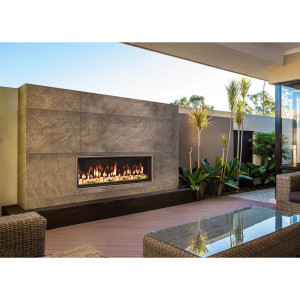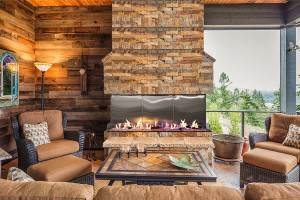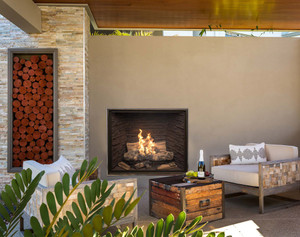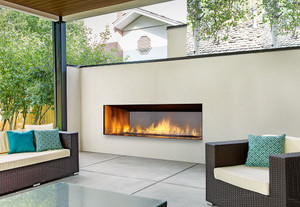Types of Outdoor Fireplaces
Natural Gas Fireplaces
These outdoor fireplaces connect directly to your home’s gas line. You get a steady fuel supply and never deal with refilling tanks. Gas supply usually is less expensive, which helps if you have an outdoor lifestyle.
Maintenance is simpler than wood burning, just clean the burners and check for leaks regularly. More info is in this outdoor fireplace buying guide.
Propane Fireplaces
Liquid Propane fireplaces use propane tanks, making these outdoor fireplaces easy to set up wherever you want.
These models warm up fast and offer lots of style choices, from modern to classic. For more details, check this list of outdoor fireplace types.
Built-In Outdoor fireplaces
Built-in outdoor fireplaces are for those who want a permanent fixture. They’re popular for custom patios or outdoor kitchens.

Usually these units are framed around non combustible materials and can be finished in brick, stone, or stucco to match your space. Installation takes some planning, measurements, ventilation, and distance from other structures all matter.
Outdoor Season Designs and Aesthetic Options for your backyard space
Outdoor fireplaces come in all kinds of looks: modern, rustic, classic. Material choices like brick or stainless steel can totally change the vibe, making the fireplace a bold statement or just a subtle touch.
Modern and Contemporary outdoor fireplaces

Modern Outdoor fireplaces focus on clean lines and simple shapes. You’ll see a lot of concrete, metal, or glass, which fits right in with today’s outdoor spaces.
Some are built flush with a wall or feature a rectangular firebox. See-through models let you enjoy the gas fire from both sides, turning the fireplace into a real gathering point.
Fire tables and built-in seating areas are popular add-ons. Privacy walls can help make the fireplace area feel like its own little retreat.
Traditional Designs
Traditional outdoor fireplaces use materials like veneer stone or brick. They usually have a mantel and hearth for that classic look. Many come with log sets that look like real wood, adding to the charm environment.

Herringbone Brick Interiors

The herringbone brick pattern is a standout feature in some fireplaces. Bricks are set at angles, making a repeating “V” design that draws the eye. Like theUrbana Outdoor fireplace. Color options range from classic red to gray or cream, but it’s really the angled pattern that makes it pop.
Stainless Steel Finishes

Stainless steel is a top feature for outdoor fireplaces, especially near the ocean or in modern spaces. It resists rust, perfect for outdoor spaces. It’s easy to keep clean and doesn’t fade much over time.
Installation Considerations for outdoor fireplaces
Putting in an outdoor fireplace for your family or friends takes some planning. You need to think about fuel setup, safety, and how you’ll ignite the fireplace. Do not skip the details and check local codes.
Connecting to a Natural Gas or Propane Line
Gas gives you steady fuel, and you’ll need a licensed gas plumber to run it outside.
Propane tanks are good if you don’t have gas service or want to install it far from the house. The local professionals will help you select the correct tank size that your outdoor fireplace needs, and make sure you use the right connectors and regulators.
Ventilation Requirements
Air circulation is key for safety and performance. Outdoor gas fireplaces use two different systems:
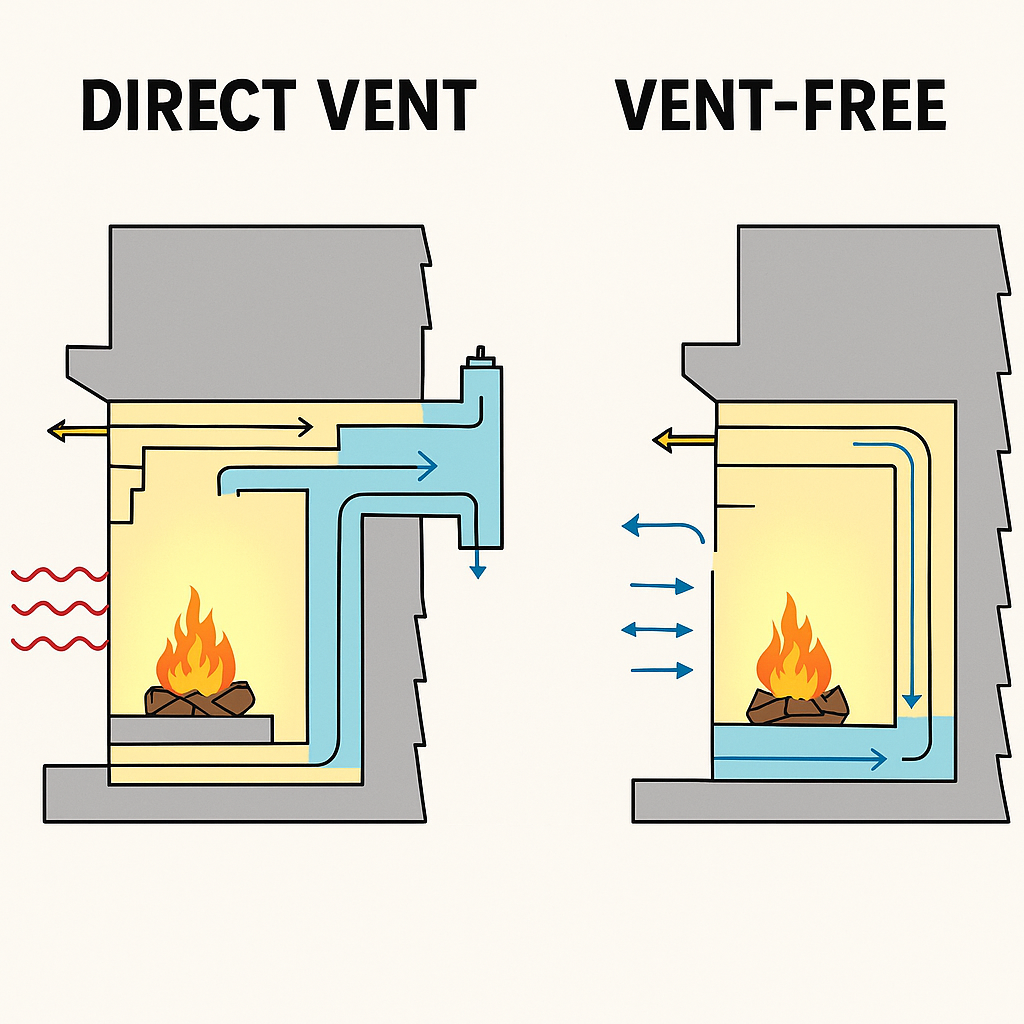
Direct vent: Sealed, has a glass front and a safety screen, draws air and exhausts from outside through a venting system. More expensive option.
Vent Free: Open fire, no glass front and optional safety screen. This units draws air from the front, this is a more popular option for a backyard space. Usually less expensive than direct vent systems, it depends on the model and manufacturer.
Ignition System Options
An outdoor gas fireplace can come with a manual ignition or an electronic ignition system. Manual systems use are a simple key valve and lighter, but is not always the easiest in bad weather.
Electronic ignition lets you start the fire with a button, switch, or remote. Most include safety features like auto shutoff if the flame goes out. These need power, so you’ll want an outlet nearby.
Performance and Heating Efficiency
Outdoor gas fireplaces heat up spaces quickly and they’re convenient and comfortable, especially when it's cold outside.
Heat Output and Coverage
Most outdoor gas fireplaces range from 20,000 to 60,000 BTUs. Some are just for small patios, while others handle larger spaces. For example, 40,000 BTUs can warm about 1,000 square feet in average weather. Wind and placement affect coverage, so keep that in mind.
The best fireplaces balance fuel use with heat output. Look for adjustable flame control options, makes a difference in comfort and cost.
Why should I consider an outdoor gas fireplace?
Enhancing Outdoor Living Areas
Purchasing an outdoor gas fireplace helps blend indoor comfort with outdoor enjoyment. Place one near a patio or seating area and suddenly your living space stretches into the yard, usable all year.
For folks who like to entertain, it’s a natural upgrade. There’s plenty of outdoor fireplace ideas out there for inspiration.
Creating a Focal Point
A gas fireplace often becomes the main focal point in a backyard. Its structure draws the eye and organizes the space visually. People use stone, brick or tile to make it stand out.
Designers sometimes add built-in benches, planters, or even an outdoor TV nearby. The fireplace it’s a gathering spot that makes the backyard feel intentional and welcoming.
Entertaining and Relaxing
An outdoor gas fireplace makes it easier to entertain in the evenings. Friends gather around, chat or enjoy dinner outside. The steady gas fire sets the mood and keeps the party going, even as it gets chilly.
Gas fires are low-maintenance. They turn on fast, don’t need firewood and the price of these range based on the size and brand. For tips, check out Montigo’s 5-step plan.
How to give maintenance to an outdoor gas fireplace
An outdoor gas fireplace needs regular maintenance to work safely and last.
Routine Cleaning and Care
Routine maintenance keeps a gas fireplace running safely and looking good. Clean the burner and glass often to get rid of soot and dust.
Check gas lines and vents at least once a year. Here are some handy tools:
Annual professional inspections are recommended. Watch for odd smells, soot buildup, or weak flames.
Longevity and Material Quality
The best outdoor gas fireplaces use stainless steel materials and, if possible, brass burners. These help prevent rust and damage from weather.
Covering the fireplace, clearing debris and keep water out, add years to the fireplace’s life.
Outdoor gas Fireplaces Frequently Asked Questions
There’s a lot to think about when selecting and servicing for an outdoor gas fireplace.
How do you determine the best outdoor gas fireplace for your needs?
It depends on the purpose of the space, your backyard or patio size, and your style. Also consider installation requirements, codes, safety, and fuel type.
What maintenance is required for an outdoor gas fireplace with a chimney?
Check for gas leaks, clean debris, and inspect the burner for cracks and chimney to prevent blockages.
Are there advantages to choosing an outdoor gas fireplace over outdoor wood fireplace?
Outdoor gas fireplaces are easier to use and need less maintenance and cleanup. Ignition is simple and often flames are adjustable.
What factors influence the cost of installing an outdoor gas fireplace?
Cost depends on the unit, labor, fuel line setup, and permits. Bigger or fancier fireplaces cost more.
How efficient are outdoor gas fireplaces in terms of heat output?
Outdoor gas fireplaces give continues heat, and you can usually adjust the output to suit the moment. They're more efficient than wood burning fireplaces, since more of the energy actually turns into heat rather than just going up with the smoke.

